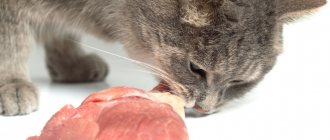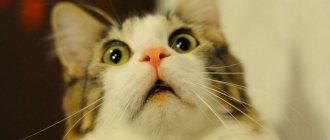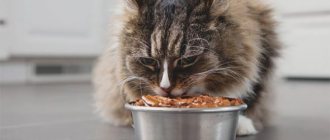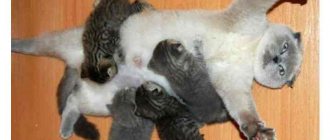Mother cat - how many times a year can she have kittens?
How many times a cat gives birth a year depends on the conditions of its existence (for “wild ones”) and the characteristics of its maintenance (for domestic ones). If she “walks on her own,” then she obeys the call of nature and often engages in sexual intercourse. On average, cats produce 2-4 litters per year. Maximum - 5 times. They carry their offspring for 9 weeks (from 58 to 72 days).
On a note! Theoretically, a cat can become pregnant 2 weeks after giving birth. In practice, there are individuals that are ready for fertilization already on the third day. If they live in rhythm with nature, they can give birth every 2 months. But this is extremely undesirable!
Responsible owners control the mating of a domestic cat and organize mating no more than 1-2 times within one year (every other heat).
On a note! With age, the intervals between births should be longer, because the animal needs more time to restore its body after bearing and giving birth to babies!
Pregnancy prevention methods
There is a myth that lactation is a natural contraceptive, and even if the cat begins to walk after giving birth, pregnancy will not happen. The claim is based on the assumption that the hormone prolactin, which causes lactation, blocks the synthesis of luteinizing hormone, which triggers ovulation. However, it is not. Ovulation in cats occurs during sexual intercourse, which is preceded by the estrous cycle. That is, sex hormones have already begun to fully work for the next fertilization, and prolactin will not affect them in any way.
The most reliable way to protect a female from an unwanted pregnancy is to isolate her from the male. If a cat and a cat live in the house at the same time, and the female shows signs of the onset of estrus, then the animals should be placed in separate rooms and not allowed near each other. With an outdoor cat that is used to free-ranging, isolation is more difficult to implement. You can either not let her go outside at all until the symptoms of the estrous cycle disappear, or you can walk her on a leash under the supervision of the owner.
If a cat persistently asks for a male, then you can calm her down with the help of sedatives for cats. After childbirth and during lactation, it is strictly forbidden to give hormonal drugs that inhibit sexual activity. It is best to consult a veterinarian about the prescription of a sedative.
Lambing four times a year! Why is this dangerous?
Many felinologists believe that the optimal interval between births in cats should be 8-14 months. When pregnancies follow one after another, the animal begins to lose weight. The cat's body wears out quickly. This leads to early aging and a decrease in overall life expectancy.
Dangers of high fertility in cats:
- sudden depletion of the animal's body;
- decreased immunity;
- exposure to infectious diseases;
- the risk of developing various diseases (necrosis, goethitis), pathologies of the respiratory system, reproductive system;
- nervous system disorder;
- rachiocampsis.
Short intervals between births have a bad effect not only on the health of the furry mother. One litter can have 2-8 cubs. If a cat becomes pregnant every time she comes into heat, there is a danger that the kittens will be born weak. Some of them do not survive, while others are susceptible to disease.
How does childbirth take place and how many hours?
In order for your cat to lamb without complications and for all the kittens to be alive and healthy, you need to help your pet.
Every pet owner should provide assistance correctly and efficiently, and know the main stages and features of childbirth.
To cope with childbirth in a cat, it is enough to familiarize yourself with the process using special literature.
If an animal develops complications before or during birth, you should definitely call a veterinarian.
How does childbirth occur in a cat?
- The first stage is determined by the beginning. Contractions can be determined in accordance with the behavior of the animal. The female begins to look for a suitable place, constantly hangs around the owners and becomes noticeably nervous, experiencing painful sensations.
- After the end of the first stage, which lasts from 12 to 24 hours, the time comes for the second. At this moment the attempts begin. The cat no longer moves, the amniotic fluid is leaking. At this moment, it is advisable to stay near the pet for as long as possible.
- The cat does not need help during the birth process. It is enough to accept the kittens and lay them down so that the new mother cannot crush or injure the babies. If the kitten walks not with its head, but with its legs forward, then the animal needs help: slightly pull the kitten by the paw forward, and then down.
Lambing will end in about 1-3 hours. The young mother will begin to lick and feed her offspring. To prevent the animal from getting up again, you need to place food and drink nearby.
For the first 3 days, it is worth closely monitoring the health of the female and the offspring. During this time, problems or pathologies will appear that may affect the further quality of life.
Useful video
Share this post
- Related Posts
- How to make liquid soap from soap remnants with your own hands: a simple method
- The benefits and harms of using pearl baths and how to prepare them at home
- How and with what to remove small midges from indoor plants: methods
- Is it possible to grow cedar from a nut at home?
- How to quickly remove brilliant green from skin
- How to descale a coffee machine using special means
Discussion: there is 1 comment
- Motherinstvo.Info:
09/15/2018 at 02:11The article contains all the necessary information for the owner of the animal, supported by a photo in order to learn how to distinguish a cat from a cat. It will also be useful to learn how to properly feed a kitten at 10-12 weeks.
Answer
Is it possible more often? Arguments for"!
How many times a year can a cat give birth? There is no consensus on this matter even among specialists and veterinarians. Some insist that endless childbirth exhausts the animal and deprives it of health, hence the conclusion that the cat needs rest.
Others strongly disagree. Purrs do not have “critical days.” Therefore, “empty heat” causes the animal no less suffering. The cat screams, loses weight, rolls on the floor, loses its fur. As a result, her psyche is disrupted, diseases and tumors appear. That is, estrus without mating undermines the health of the animal no less than the next birth.
Many cats painfully endure an unsuccessful estrus, and their health worsens. How many times a year can a cat give birth if she is young and healthy, easily tolerates pregnancy, gives birth on her own and without problems? It can be knitted more often - up to 3-4 times.
Some experienced breeders do just that: they “allow” their cat to give birth to offspring three or four times a year. But all this happens under the strict supervision of a doctor. The meowing mother is provided with proper, nutritious nutrition and is given vitamins. This allows the cat to remain in good physical shape, and its offspring are born strong and healthy.
It is incorrect to compare a cat with a person. Nature designed animals differently. If you let her give birth once a year, and not regularly, then childbirth can be very painful and problematic.
Rules for caring for newborn kittens
Reliable shelter
The cat herself finds a place in which it will be convenient for her to care for newborns. Usually chooses boxes, cabinets and other dark places. A common ritual of all representatives of the cat family is to hide their cubs in secluded places.
During the period when babies begin to open their eyes, bright light disorients babies, since the lens of the eye cannot respond adequately to different lighting conditions.
If the cat does not like the place the owner has arranged, she can carry the kittens.
The nest can be built from any spacious box, having previously placed bedding there - old clothes or absorbent diapers.
Hygiene
A mother cat cannot always ensure complete cleanliness in her nest.
One way or another, baby excrement ends up in the box, so it’s important to change the bedding
This also applies to kittens. They need to wipe their eyes and nose daily with a strong infusion of tea to prevent the development of microflora on the mucous membranes of these organs.
Periodically, the babies are wiped with a damp cloth - the mother cat does not always have time to lick her babies. There is no need to arrange thorough bath procedures.
How many times a year can a “teddy” cat become a mother?
Today British cats are very popular. How many times a year do such beauties give birth? This worries animal owners and breeders, because the sale of cute kittens is a significant source of their income.
British females reach maturity later than eastern breeds. A cat who has not yet been pregnant comes into heat once every 2-3 weeks. For the one that has already been knitted - once every 3 months.
On a note! It is forbidden to breed during the first heat. This can negatively affect the cat's health! You can knit it from 1.5 years (over 12 months).
The cat “walks” up to four times a year. But this does not mean that she should get pregnant every quarter. For breeding cats, there are the following rules: the next mating can be done 6 months after the birth of kittens or 3 times in 2 years. And upon reaching 7 years of age, cats are removed from breeding.
Cat pregnancy: physiological characteristics and duration
A pet's first heat can begin as early as 6 months of age. It is advisable not to mate animals during this period, as this may harm the cat's health.
It is better to breed purebred cats starting from 1 year of age, when several heats have already passed and the pet’s body and psyche have become stronger. Domestic cats usually retain the ability to give birth until they are 15 years old, but it is better to stop mating already at the 8th year of life: the older the animal becomes, the weaker its kittens are and the greater the likelihood of diseases in the offspring. It is impossible to diagnose pregnancy immediately; for this you need to wait 20-25 days. A veterinarian will help you accurately determine that your pet is pregnant after an examination at the veterinary clinic.
Abyssinians carry slightly smaller offspring than long-haired beauties.
Cats that walk outside have a higher chance of becoming pregnant than other pets. But owners who want to breed kittens recommend monitoring the mating: casual sexual intercourse leads to a deterioration in the genetics of the offspring, and kittens are born with congenital pathologies. Pregnancy lasts on average up to 9 weeks, but the duration depends on the cat breed: short-haired individuals (Abyssinian, Russian Blue) bear kittens for 58-68 days, and long-haired individuals (Persian, Siberian) - 63-72 days. During this time, the animal should be given special dry food for pregnant cats and a complex of vitamins.
Your pet's food should contain the following nutrients:
- proteins;
- amino acids;
- carbohydrates;
- vitamins.
How to come to an agreement with nature? Ways to regulate a cat's basic instinct
When the time comes, the cat doesn’t just ask for a cat, she demands it. The cat literally goes crazy and does not allow all the inhabitants of the house to live in peace. If the owners for some reason do not want her to become a mother, then they will have to resort to medication.
To suppress sexual desire, but not harm the cat’s health, use (after consulting a doctor!) non-hormonal products that contain herbs (thyme, mint, oregano). These drugs include: Stop - stress, Kot Bayun, Mating-minus. They calm the animal and reduce sexual desire.
If having kittens is not part of your plans, but you want to keep your pet healthy, then do not give her contraceptives that grossly interfere with the hormonal balance and disrupt it (Contrasex, Ex, Sex Barrier).
How often is it safe for a cat to give birth?
If the female who gave birth does not have serious health problems and after giving birth the disturbed hormonal levels return to normal, then after 1.5-2 months the animal may begin to go into estrus. However, the owner, in order to avoid dangerous complications, is prohibited from organizing re-breeding. It will take at least 9-12 months to restore the body. Therefore, veterinarians advise breeding females no more than once a year.
If the female starts asking for a cat immediately after the babies appear, then she is even capable of abandoning them.
With hormonal dysfunction, sexual heat can occur almost immediately after lambing. In this situation, not only the cat suffers, but also her cubs. The animal refuses its litter, perceiving it as someone else's kittens, runs away, rushes around the house in search of the cat, screams, and leaves marks on the floor. Such symptoms cannot be ignored; the pet must be taken to the veterinarian as soon as possible. After a diagnostic study, the doctor will prescribe a comprehensive treatment regimen that will help normalize the animal’s hormonal levels.
When cats purr
Now let's look at the question of when our pets purr. There are quite a few situations when a cat wants to “sing” a little, for example:
- A mother cat may purr to calm her babies, letting the kittens know that they are safe;
Kittens or cats purr when you stroke them, showing their pleasure (in general, when cats purr next to a person, this should be taken as a symbol of the animal’s devotion and love for its owner);
The animal, in complete peace and complacency, after playing and communicating with the owner, decides to get some sleep (remember situations when a cat purrs and tramples you with its paws);
The pet, with the help of purring and stamping its paws, tries to improve the health of its owner (i.e., the animal calms the person and gives him a therapeutic massage);
As we mentioned above, many cats purr loudly when they smell the aroma of their favorite food;
Male cats may begin to purr at the sight of another weaker mustachioed opponent, as if letting their enemy know that there will be no attack;
Cats sometimes purr during pregnancy and when they are scared. It is believed that this is how they calm themselves down and tune in to peace. And during illness, pets sometimes purr to bring their blood circulation back to normal;
Our pets sometimes purr even before death (the last and saddest cat song). Why? Who knows, maybe this is how they say goodbye to their owner?
What to feed a newborn kitten?
Often a baby, as soon as it is born, is deprived of maternal care. To save a kitten from imminent death, the owner must put in a lot of work and patience. In such a situation, the first thing you need to do is contact a veterinarian. The specialist will tell you when kittens begin to feed themselves, explain how to replace cat milk, and help you create a diet for a newborn.
For the first month, your pet needs to be fed approximately eight times a day. Mother's milk should be replaced with cow's milk and given warm. Since the baby does not know how to do anything yet, it is advisable to use a pipette for feeding. In the future, all complementary foods should be introduced slowly.
It is very important. First, add unsweetened semolina porridge to your diet, cooked in milk diluted in a ratio of 1:2
After stool normalization, you can diversify your pet’s menu with rice, rolled oats or buckwheat. In the case when the kittens begin to eat the offered dishes themselves, you can diversify their diet with a small amount of low-fat cottage cheese.











